This article is part of a series of explainer pieces by the Voice on some of the most important topics on campus. Other articles in the series can be found here.
Georgetown’s bureaucracy can be overwhelming, to say the least. It takes a lot to run any university, and the sheer number of administrative positions can make it difficult for students to understand where decisions are coming from, and who the people that run their university are.
We at the Voice hope to combat that confusion with a set of university-wide organizational charts that explain which administrators are responsible for what and identify some of the people who work behind the scenes to craft university policy.
The following charts were made in August of 2020, so any subsequent changes in organization or hiring for positions are not reflected. The charts are mainly based on publicly available information and have not been verified by the university.
The Board of Directors
The Board of Directors (BOD) is composed of between 10 and 50 (currently 38) individuals who are tasked with approving all major changes made by the university, including in educational programs, tuition, the budget, and university buildings and land. The BOD appoints the president and approves the president’s nominations of a provost, secretary, and treasurer (who is also called the chief financial officer).
Directors serve three-year terms and are elected by other members of the BOD at annual meetings. According to Georgetown’s bylaws, directors can serve up to two terms at a time and can be reelected for as many terms as they like as long as one year passes between each six-year period they serve on the Board.
Most members are alumni or have a connection to the university, the Washington D.C. area, or the Jesuit order, though those connections are not mandated to serve on the Board. The university president, chairman of the board of regents, president of the alumni association, and CEO of Medstar are automatically granted seats on the Board.
The Board is led by a chair and three vice-chairs. The current chair is William Doyle (COL ‘72), and the Vice-chairs are Sr. Carol Keehan, Timothy J. O’Neill (LAW ’77), and Fr. Daniel Villanueva, (GEMBA ’15). Most work in the BOD is done in one of the committees illustrated below, which include between five and 15 members each.
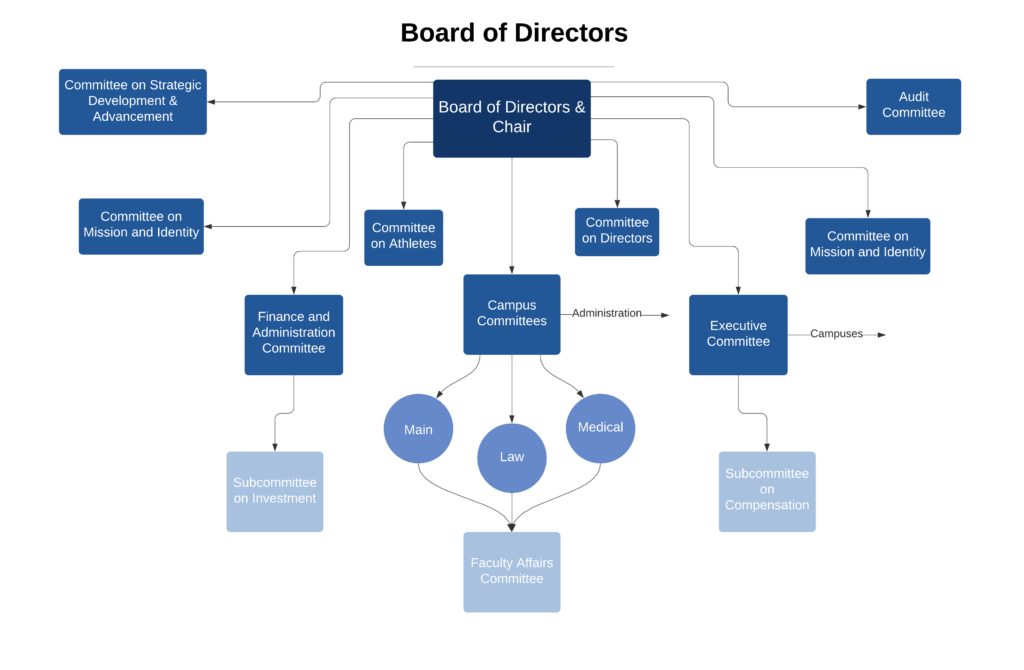 Chart by Cassi Sullivan
Chart by Cassi Sullivan
Committees
- Executive Committee – The executive committee is the primary body for the BOD to advise the president. They can act on behalf of the entire Board if needed, deal with issues of major university policy, and set agendas for BOD meetings. They also review any identified risks and provide oversight.
- Subcommittee on Compensation – This committee, made up of members of the executive committee, reviews the performance of the president and recommends a salary. They also review the president’s assessments of other high-level employees, and advise the president on compensation levels for those employees.
- Committee on Strategic Development and Advancement – This committee focuses on the future of the university, working on long term planning, public and alumni relations, and fundraising and development efforts.
- Audit Committee – The audit committee acts as an oversight body for the university’s financial reporting, internal and external audits, risk management, and compliance. They approve internal audit plans, and work with related administrators.
- Finance and Administration Committee – The Finance and Administration Committee oversees university use of funds and resources and monitors financial strategies and operations.
- Subcommittee on Investments – The subcommittee handles the investment of the university’s endowment and helps to set university investment policies.
- Committee on Directors – This committee acts as an internal administrative body, and is tasked with recruiting directors, integrating them into the BOD, and assessing their performance.
- Committee on Global Engagement – This committee helps the university create international programming and maintain a positive image around the world.
- Committee on Athletics – The committee on athletics works with university officials to oversee athletics programs and policies.
- Campus Committees – There is one campus committee for each campus (Main, Law, and Medical Center) to deal with campus-specific issues.
- Faculty Affairs Committee – This committee oversees faculty development and university-wide faculty concerns. The committee is composed of the chair of the BOD, the president, and the chair of each of the campus committees.
- Committee on Mission and Identity – This committee is tasked with helping to ensure Georgetown is upholding its religious identity and is fostering Jesuit values in students and faculty.
The Administration
The administration includes employees of the university who oversee academics, student affairs, and university affairs. The dozens of departments under the administration are divided into two main sections: university services and campus services. University services are overseen by the senior vice president (also called the chief operating officer) while each campus is overseen by their provost or executive vice president. While each campus, Main Campus, the Law Center, the School of Medicine, and the Qatar campus, has a different structure, we have focused on the main campus as it makes up the largest administrative body. The first chart will illustrate the structure of the executive officers, while subsequent charts will examine university services and the structure of the main campus.
Executive Officers
These seven positions serve as the executive leadership for the university and are appointed by the president.
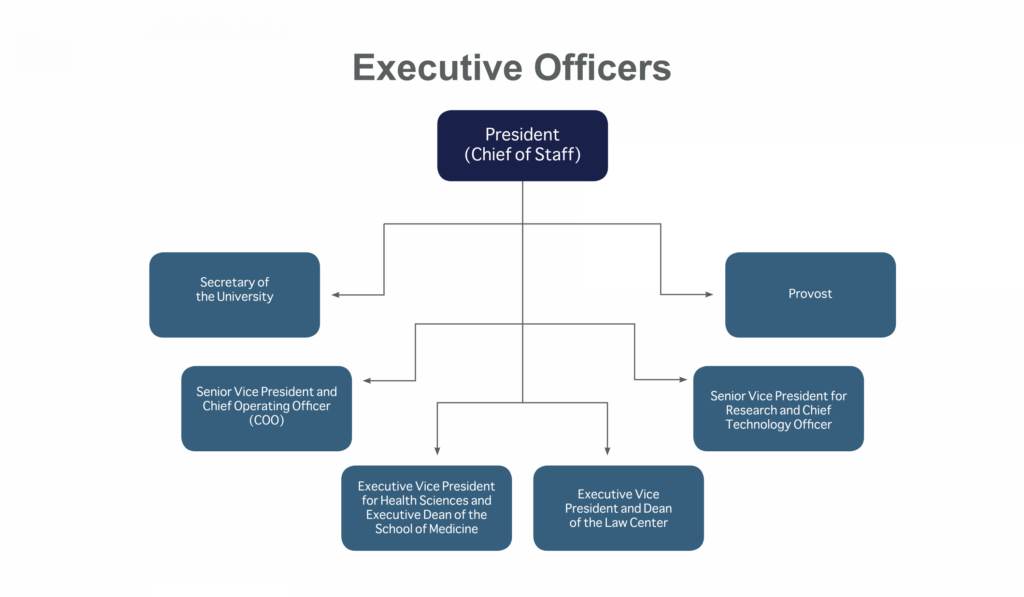 Chart by Liv Stevens
Chart by Liv Stevens
- President – The position of university president, which is currently filled by John DeGioia, is chosen by the BOD. They are in charge of long-term university initiatives and creating a university culture, both on campus and to present to the world. Most big decisions are made by the president in consultation with the BOD. The president also serves as a liaison between the BOD and the administration and has a place on most BOD committees. DeGioia is the first president who was not also a member of the clergy.
- Chief of staff – The president is served by their chief of staff, currently Joe Ferrara.
- Secretary of the University – Currently filled by Marie Mattson, the position of university secretary is one of four mandated by Georgetown’s bylaws. The secretary serves both the president and the BOD and liaises between the two. They also work on special projects, and work with the BOD to recruit new members, increase engagement, and plan meetings and retreats.
- Provost – The provost, currently Robert Groves, runs academic and administrative operations for the main campus, and serves as executive vice president of that campus. This includes overseeing Georgetown College, the Graduate School of Arts and Sciences, the Walsh School of Foreign Service, the McDonough School of Business, and the School of Continuing Studies, as well as Lauinger Library and the Georgetown Public Policy Institute. Other departments under the provost include the registrar, student financial services, and student affairs.
- Executive Vice President and Dean of the Law Center – This position, currently filled by William Treanor, essentially serves as the provost of the law school and leads both its academic and administrative offices. They are the final authority on all Law Center-specific issues unless they require the president’s attention.
- Executive Vice President for Health Sciences and Executive Dean of the School of Medicine – This position acts as the provost and final authority for all departments in the School of Medicine. Edward Healton currently oversees the medical campus, including academic and administrative offices for the School of Medicine, School of Nursing and Health Studies, Lombardi Comprehensive Cancer Center, and the Biomedical Graduate Research Organization.
- Senior Vice President and Chief Operating Officer (COO) – The COO is responsible for administrative issues across all campuses, focusing on financial and operational departments. Geoffry Chatas, the current COO, oversees nine members of senior leadership who run departments across campuses.
- Senior Vice President for Research and Chief Technology Officer – This last senior vice president, currently Spiros Dimolitsas, oversees a team of about a dozen scientific and research advisors and employees with a focus on health data analytics, security, and sustainability. The office’s mission is to conduct research on relevant current issues and create partnerships with organizations to facilitate research.
University Services
The first side of Georgetown operations provides administrative services across all of the university’s campuses. Headed by Chief Operating Officer Geoffry Chatas, the offices that work in the department mainly handle the inner workings of the university, including oversight and financial affairs. They also offer resources for faculty and students through the offices of Human Resources, Institutional Diversity, Equity and Affirmative Action, and Mission and Ministry.
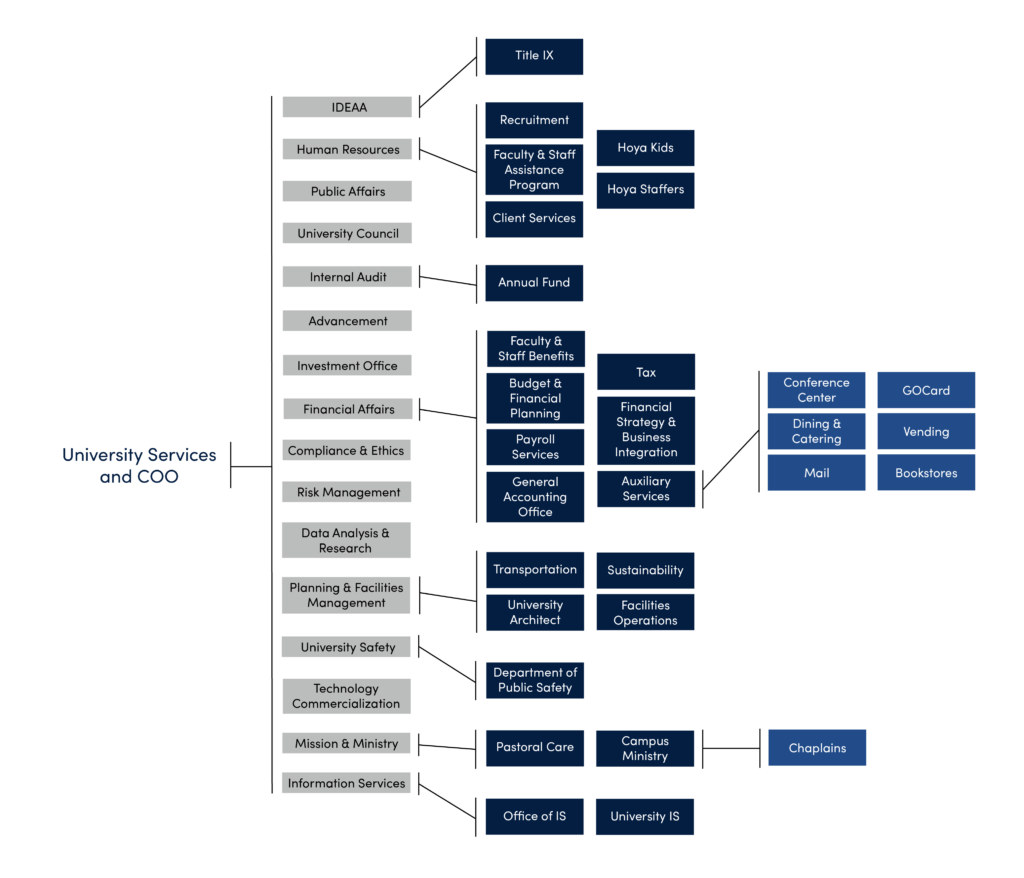 Chart by Insha Momin
Chart by Insha Momin
COO – In addition to their other responsibilities, the COO oversees all the offices under university services. Three different lists exist of what these offices include, but they have all been listed here under university services.
- Office of Advancement – Headed by the Vice President for Advancement, currently R. Bartley Moore, this office handles alumni relations and university fundraising campaigns. They also oversee the annual fund and specific giving campaign for regions and schools.
- Annual Fund – This fund, which is made of donations to the university, supports annual scholarships, support, and resources. It is managed by Associate Vice President for Alumni Relations and Annual Fund William Reynolds.
- Office of Compliance and Ethics – Headed by the Associate Vice President for Compliance and Ethics and Associate University Counsel James Ward, this office works across departments in the university to ensure compliance with regulations and best practices. They administer the university whistleblower policy and handle employee reporting. They also create and distribute the code of ethical conduct and manage the protection of minors policy.
- Office of University Counsel – Led by Vice President and General Counsel Lisa Brown, the team of university counsel provides legal services to the university, faculty, and staff.
- Office of Planning & Facilities Management – Headed by the Vice President for Planning and Facilities Management Benjamin Kuo, this office provides “community services related to campus and space planning, design and construction, real estate, facility maintenance, utilities, grounds, custodial, transportation and parking,” according to its website. This includes GUTS buses, the Office of Sustainability, the university architect, and general facilities operations, such as maintenance, custodial services, and energy and utilities.
- Transportation – This office oversees GUTS buses and parking. They also provide information about alternative transportation options available near campus.
- Sustainability – This office, led by Audrey Stewart, supports research and education related to sustainability studies, as well as leading sustainability initiatives on renewable energy and conservation and providing information for students on individual action.
- University Architect – Architect Gina Bleck and her team work on long-term campus planning projects and oversee the construction of those projects.
- Financial Affairs – This office, led by Chief Financial Officer (CFO) David Green, serves as the main administrative unit for financial issues, such as assets and liabilities, financial reports and analysis, payroll, accounting, contracts, and investments. Green handles long-term financial budgeting and planning, as well as overseeing central financial functions. The CFO also serves as the “treasurer” mandated by university bylaws. The following vice presidents and offices each specialize in a different aspect of financial administration.
- Stella Apesky – Senior Associate Vice President for Budget, Financial Planning and Treasury Management
- Willem Roos – Comptroller of General Accounting Office
- John Kotwicki – Associate Vice President for Tax & Special Assistant to the Vice President for Finance
- Adam Donaldson – Associate Vice President, Financial Strategy & Business Integration
- Rebecca Risley – Director of Payroll Services
- Investment Office – Led by Chief Investment Officer Michael Barry, this office manages investments from the endowment and pension plans.
- Office of Faculty and Staff Benefits – This office manages benefits, including health and retirement, for all university employees.
- Auxiliary Business Services – This office manages outside contracts with providers, working with the bookstore, dining services, GOcard, catering, commercial property, mail services, vending, off campus housing, and area hotels. It is currently led by Vice President for Auxiliary Services Marc Fournier.
- Human Resources – HR, currently led by Interim Vice President Marshall Taylor, handles relations with employees, including employment services, recruitment, client services, employee training, Hoyakids, and the Faculty and Staff Assistance Program. Each department in the university also has a designated HR generalist who is intended to serve as a resource.
- Information Services – The Chief Information Officer, currently Judd Nicholson, oversees technology policies and daily operations through two departments.
- Office of Information Services – This office deals with long term and strategic planning of technology policy.
- University Information Services – This office carries out daily operations, works on university technological infrastructure, and helps users with problems.
- Office of Institutional Diversity, Equity and Affirmative Action – The mission of this office, led by Vice President for Diversity, Equity & Inclusion, and Chief Diversity Officer Rosemary Kilkenny, is to create an inclusive academic and work environment through conversations about diversity and access. This mission is promoted through working to ensure equal opportunity and affirmative action, administering the cultural climate survey, and advocating for accommodations, as well as the work of the office below.
-
- Title IX Office – This office, led by coordinator Samantha Berner and investigator Sarah Onori handles complaints of gender-based discrimination, including allegations of sexual misconduct and addresses resources for survivors of sexual assault and harassment.
-
- Office of Mission and Ministry – This office, led by Vice President for Mission and Ministry Rev. Mark Bosco, heads all faith initiatives on campus and supports Jesuit values through on-campus initiatives that combine education and faith.
- Campus Ministry – Led by Father Greg Schenden on the main campus, these ministries deliver faith to students and campuses. Within each campus, there is a faith chaplaincy for Christian Life, Jewish Life, Protestant Life, Orthodox Christian Life, Muslim Life, and Dharmic Life. Other religious initiatives include athletics ministers, residential ministers, musicians, ESCAPE, Calcagnini Contemplative Center, and Interreligious events.
- Department of Mission and Pastoral Care – In conjunction with the hospital, this department provides spiritual support for families and patients for those receiving care.
- Office of Public Affairs – This office, headed by Erik Smulson, Vice President for Public Affairs and Senior Advisor to the President, represents the university to external groups such as media and governments, communicates news internally, and develops a communications strategy.
- Office of Risk Management – This office, led by Associate Vice President Joseph Yohe, handles the university’s insurance portfolio, workers’ compensation, and claims. They also offer risk management services and try to prevent university loss.
- Internal Audit Office – Headed by Chief Executive Auditor Frank Maggio, the office evaluates internal controls and risk management in business, financials, information systems, and organizational roles. The office conducts an annual risk assessment.
- University Safety – The office of university safety oversees the emergency preparedness plan, public safety, and connections with local law enforcement.
- Office of Technology Commercialization – This office, led by Vice President Claudia Cherney Stewart, manages inventions, patenting, confidentiality, and partnerships with local businesses.
- Office of Data, Analytics, and Research – This office serves the university by improving the capacity for data analytics both for university growth policies and the general academic community.
- Additional staff – These staff did not seem to be associated with any particular department other than the COO’s office but serve as vice presidents.
- Vice President for Corporate Partnerships – Currently Lori Baldwin, the person in this position works to form relationships with corporations and external groups for the university.
- Associate Vice President for Operations – Currently Christina Roberts, the person in this position oversees general operations initiatives, strategy, and improvements.
Main Campus
Main campus affairs, both academic and student affairs, are overseen by Provost Robert Groves. Most departments that students interact with on a daily basis are part of one of these departments, including residential living and student health. The provost also is responsible for additional academic units, institutes, centers, and programs. Provosts on other campuses oversee similar structures, adapted for the needs of each campus. The offices under this office are so numerous, they have been divided into two charts.
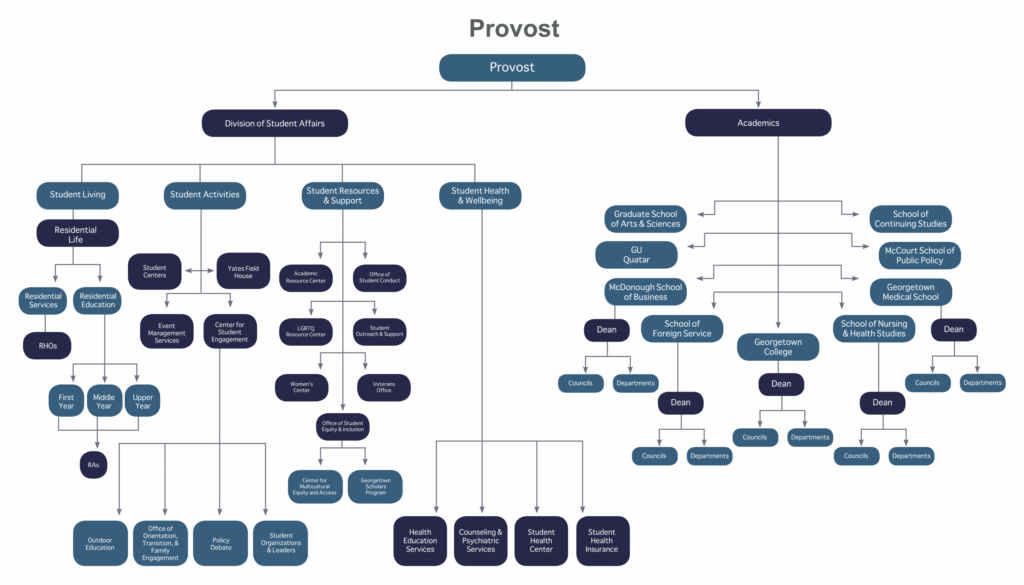 Chart by Liv Stevens
Chart by Liv Stevens
Provost
The provost, in conjunction with a series of directors and vice presidents that can be found here, oversees nearly twenty main campus schools, academic units, and programs. These units are responsible for the day to day experience of students, and Provost Groves helps coordinate across each of them.
Schools
All purely academic affairs, including academic classes, departments, and research, are run through one of the seven main campus schools. Each school is headed by a dean and led by a combination of administrative staff and department chairs. The four main schools (SFS, College, NHS, MSB) also each have executive councils composed of the dean, vice deans, representatives from academic units, and undergrad and grad students. The deans of each school are below.
- Edmund A. Walsh School of Foreign Service – Joel Hellman
- Georgetown University in Qatar – Ahmad Dalla
- Georgetown College – Christopher Celenza
- McCourt School of Public Policy – Maria Cancian
- Graduate Schools of Arts and Sciences – Alexander Sens, Interim
- McDonough School of Business – Paul Almeida
- School of Continuing Studies – Kelly Otter
Division of Student Affairs
Though the division of student affairs is technically just one of the academic units on the main campus, it is by far the largest and most encompassing, so for clarity, it will be presented as a separate set of offices. It is headed by the Vice President for Student Affairs Todd Olson, who oversees non-academic student resources and services on the main campus.
- Office of the Vice President – This office acts as the administration for all other offices in the division. It also includes Dean of Students Jeanne Lord. They handle any overarching projects and initiatives between departments within student affairs.
- Residential Living – Residential Living, which is led by the Assistant Vice President of Student Affairs Stephanie Lynch, is split into two main divisions to serve students living on campus.
- Residential Services – Led by Director Bill Huff, this office handles RHOs, room assignments, marketing, summer programs, and main office duties, overseeing most of the administrative work of residential living. One associate director position for RHOs, furniture, and facilities issues is currently vacant, and the other one that handles assignments and summer programs is filled by Krista Haxton.
- Residential Education – Led by Director Eddie Carreon and Associate Director Katie Heather, this division oversees community building in residential spaces. It is further divided into three main subdivisions based on year. In each community, each building also has a community director and each floor has one or two RAS.
- First Year (Darnall, Harbin, New South, VCW)
- Assistant Director: Eileen Rodriguez
- Middle Year (Arrupe, Copley, SWQ, FJR, VCE)
- Assistant Director: Lavon Davis
- Upperclassmen (Vil B, Townhouses, Henle, LXR, Nevils, Vil A)
- Assistant Director: Katherine Himmelman
- First Year (Darnall, Harbin, New South, VCW)
- Student Activities – This group of offices oversees student organizations and helps students execute events and projects. It also includes student amenities, like Yates.
- Center for Student Engagement – The CSE, led by Director Aysha Dos and Associate Director Jaime Brown supports student engagement across campus by facilitating the formation of new clubs and club funding. They also help club leaders with initiatives and run university-based programs that students are involved in, such as those below.
- Outdoor Education – This program allows students to direct others on hikes, water activities, and camping trips. Director Kris Nessler helps run more than 40 trips a year.
- Office of Orientation, Transition, and Family Engagement – Through this office, Director Matt Barnes runs new student orientation, oversees pre-orientation programs, and creates programming designed to welcome first-year students to campus.
- Policy Debate – Led by Mikaela Malsin, the university debate team travels to compete with other schools.
- Georgetown Event Management Services – Led by Director Phylander Pannell, this office handles university event spaces and facilities and manages event requests both from campus and outside organizations. They also help facilitate spaces for summer events.
- Student Centers – This department oversees the major student centers on campus, the Healey Family Student Center, and Leavey. Led by Patrick Ledesma, they help put on campus-wide events and reserve spaces for groups.
- Yates Field House – Yates, which is free of charge for undergraduate students, has fitness areas and courts. They also host workout classes for members.
- Center for Student Engagement – The CSE, led by Director Aysha Dos and Associate Director Jaime Brown supports student engagement across campus by facilitating the formation of new clubs and club funding. They also help club leaders with initiatives and run university-based programs that students are involved in, such as those below.
- Student Resources & Support – This group of offices provides support for students, including students of specific identities. They also handle student conduct and general issues of equity and inclusion.
- Academic Resource Center – Led by Joseph Fisher, this center provides support for students with disabilities, as well as student-athletes and general academic support. Accommodations requests are processed through this office, and they also provide foreign language tutoring.
- Office of Student Equity & Inclusion – The OSEI houses the CMEA and GSP and serves to create collaboration between historically marginalized student groups and promote access and support as an umbrella office. It was founded in 2019 and is headed by Adanna J. Johnson, associate vice president for student equity & inclusion.
- Center for Multicultural Equity and Access – The CMEA’s mission is to “enhance the education of students historically denied access to GU because of race, ethnicity, national origin, socioeconomic status, and other marginalized identities.” To this end, the center creates spaces and hosts programs specifically to elevate certain cultures or identities. La Casa Latina, Black House, Hoya Saxa Weekend, and the Community Scholars Program are all run through the CMEA, which is headed by Director Charlene Brown-McKenzie.
- Georgetown Scholars Program – GSP, which provides programming and support for a selected group of low-income and first-generation students, is headed by Executive Director Missy Foy in conjunction with a student board. The program serves more than 600 undergraduates every year.
- LGBTQ Resource Center – The center provides programming and resources for all students on campus, with a focus on providing a safe space for lesbian, gay, bisexual, transgender, non-binary, and questioning students. They help organize OUTober and Lavender Graduation every year, along with holding weekly office hours. The center has been headed by Shiva Subbaraman since its founding in 2008 and is mainly staffed by students.
- Office of Student Conduct – The Office of Student Conduct, led by Director Judy Johnson, enforces code of conduct regulations through holding hearings and appeals for students who violate the code. They also provide students with their records on request.
- Student Outreach and Support – Led by Director Katie Boin, this office connects students with resources on campus and offers a “safety net” where students can anonymously report that another student may need support. They organize support for students in crisis and returning from psychiatric care or medical leave of absence.
- Veterans Office – The Veterans Office provides resources to those who are veterans or currently serving, including helping students find military education funding, making accommodations for military obligations, and aiding veterans in their transition to the classroom.
- Women’s Center – The Women’s Center serves as a resource to female students, as well as providing information on women’s health and wellness and eating disorders, breast cancer screenings, pregnancy tests, sexual health, and gender-based violence and harassment. The center is also led by Shiva Subbaraman.
- Student Health and Wellbeing – These offices provide physical and mental health care to students. The offices are led by the assistant vice president for student health, most recently Vincent WinklerPrins.
- Counseling and Psychiatric Services – CAPS provides mental health and counseling services to students. It is led by Director Phil Meilman.
- Health Education Services – HES provides education on healthy living and is the primary consultation and treatment location center on campus for students experiencing problems with substance abuse, eating disorders, sexual assault, relationship violence, stalking, and pregnancy. Led by Director Carol Day, the center also provides confidentiality on most services and advises student sexual assault peer educators.
- Student Health Center – Led by Director Leanna Lash, the health center provides general medical services, including immunizations, to students. A complete list of the services they provide can be found on their website.
- Student Health Insurance – This office manages health insurance for all students who opt to be on the Georgetown plan. In addition to coordinating insurance and ensuring every student is covered, they process claims and provide additional plans for students studying abroad. Led by Director Laura Crosby, they are also responsible for negotiating plans each year with the insurance provider.
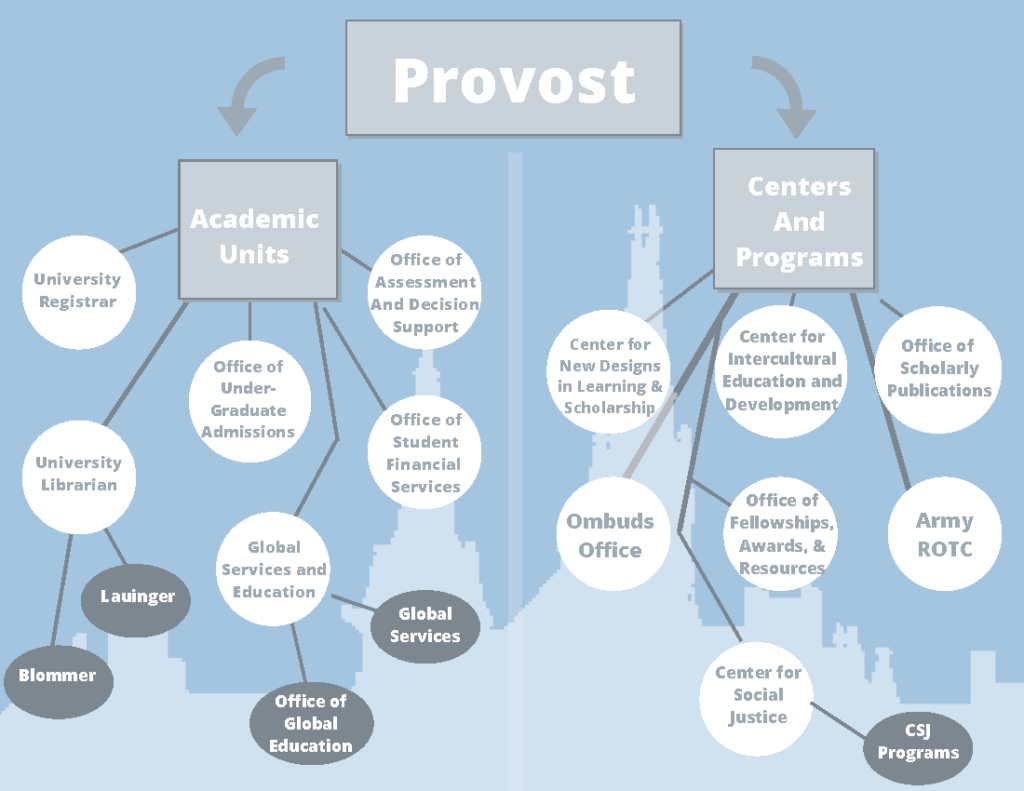 Chart by Neha Malik
Chart by Neha Malik
Academic units
In addition to the Division of Student Affairs, these academic units provide resources and services across departments and main campus schools. They are all overseen by the provost.
- Global Services and Education – This office, headed by Craig Rinker, director of Global Education, handles study abroad planning and programs for students. Advisors for regions and programs work directly with students to plan classes and acquire financial aid.
- Libraries – The university librarian, currently Harriette Hemmasi, oversees the operations of Lauinger and Blommer Libraries. This includes Gelardin Media Center and research support, as well as other library services.
- Office of Assessment and Decision Support – The OADS creates university policy for surveying students and handles university data collection and research through maintaining the Common Data Set, the Integrated Postsecondary Data System, and guidebooks. The office is led by Drew Allen, associate vice president for Institutional Data Analytics.
- Office of Student Financial Services – This office handles all student financial aid applications and awards. They also provide resources for outside scholarships and grants, information for student work-study, and work with CSP and GSP students. The office is led by Dean of Student Financial Services Patricia McWade.
- Office of Undergraduate Admissions – Led by Charles A. Deacon, dean of admissions, this office handles all applications to the university, as well as visits to campus and outreach to potential applicants. They also run the alumni interview process.
- University Registrar -The registrar, currently Annamarie Bianco, handles academic administrative information, including the academic calendar, schedule of classes, and enrollment in classes. They also provide transcripts and diplomas, maintain MyAccess, run CETS, and create the undergraduate bulletins that act as a guide for students.
Institutes, Centers, and Programs
These organizations provide additional services through students for specialized areas of education or student life.
- Army ROTC – The Hoya Battalion, led by Director Gabriel Wolfe, serves as the ROTC branch on campus. They handle recruitment and training of cadets, as well as programming for specialized teams.
- Center for New Designs in Learning and Scholarship – CNDLS serves as a teaching and learning center that promotes the use of educational technology. They support projects and research that examine new ways of learning. The center is led by Edward Maloney, executive director.
- Center for Intercultural Education and Development – The CIED develops international programs for the university-based in partnerships with governments, private companies, and NGOs. Led by Executive Director Chantal Santelices, the staff helps design programs for interested organizations. Programs do not necessarily include Georgetown students.
- Center for Social Justice Research, Teaching and Service – The CSJ provides social-justice-oriented programs that allow Georgetown students to serve their community and educate themselves about disparities. They provide work-study and volunteer opportunities to students through programs such as DC Reads and After School Kids. The center is led by Andria Wisler, executive director.
- Office of Fellowships, Awards, and Resources – Led by Director John Glavin, GOFAR helps students and alumni apply for scholarships and fellowships, as well as providing general development resources.
- Office of Scholarly Publications – The office of scholarly publication helps faculty publish their research with universities and academic journals. The office is led by Carole Sargent, director.
- Main Campus Faculty Ombuds Office– The ombuds office, led by Catherine Langlois, handles workplace concerns for faculty dealing with rank and tenure, conflicts with colleagues, academic dishonesty, and discrimination or harassment.
This organizational chart is by no means exhaustive and has not been verified by the university. If you wish to share another office or have reason to believe there is an inaccuracy, please contact us at news@georgetownvoice.com.
Patrick Walsh contributed reporting



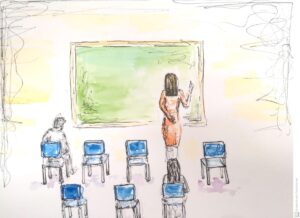
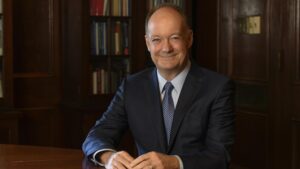
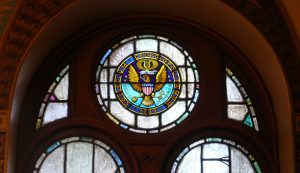
[…] READ MORE FROM SOURCE ARTICLE […]
[…] — to georgetownvoice.com […]
[…] Georgetown Explained: University organizational chart – The Georgetown Voice […]
[…] Georgetown Explained: University organizational chart – The Georgetown Voice […]
[…] Read full Story ➤ […]